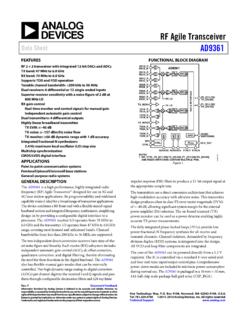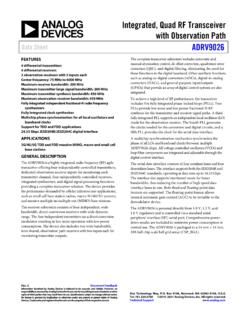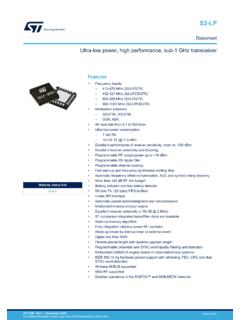Transcription of KSZ9031MNX - Gigabit Ethernet Transceiver with GMII/MII ...
1 2016-2017 Microchip Technology Inc. DS00002096E-page 1 Features Single-Chip 10/100/1000 Mbps Ethernet Trans-ceiver Suitable for IEEE Applications GMII/MII Standard Interface with Tolerant I/Os Auto-Negotiation to Automatically Select the Highest Link-Up Speed (10/100/1000 Mbps) and Duplex (Half/Full) On-Chip Termination Resistors for the Differential Pairs On-Chip LDO Controller to Support Single Supply Operation Jumbo Frame Support Up to 16 KB 125 MHz Reference Clock Output Energy-Detect Power-Down Mode for Reduced Power Consumption When the Cable is Not Attached Wake-On-LAN (WOL) Support with Robust Cus-tom-Packet Detection Programmable LED Outputs for Link, Activity, and Speed Baseline Wander Correction LinkMD TDR-based Cable Diagnostic to Identify Faulty Copper Cabling Parametric NAND Tree Support to Detect Faults Between Chip I/Os and Board Loopback Modes for Diagnostics Automatic MDI/MDI-X Crossover to Detect and Correct Pair Swap at All Speeds of Operation Automatic Detection and Correction of Pair Swaps, Pair Skew, and Pair Polarity MDC/MDIO Management Interface for PHY Reg-ister Configuration Interrupt Pin Option Power-Down and Power-Saving Modes Operating Voltages- Core (DVDDL, AVDDL, AVDDL_PLL): (External FET or Regulator)- VDD I/O (DVDDH): , , or Transceiver (AVDDH): or (Commercial Temp.)
2 64-pin QFN (8 mm 8 mm) PackageTarget Applications Laser/Network Printer Network Attached Storage (NAS) Network Server Broadband Gateway Gigabit SOHO/SMB Router IPTV IP Set-Top Box Game Console IP Camera Triple-Play (Data, Voice, Video) Media Center Media ConverterKSZ9031 MNXG igabit Ethernet Transceiver with GMII/MII SupportKSZ9031 MNXDS00002096E-page 2 2016-2017 Microchip Technology OUR VALUED CUSTOMERSIt is our intention to provide our valued customers with the best documentation possible to ensure successful use of your Microchipproducts. To this end, we will continue to improve our publications to better suit your needs. Our publications will be refined andenhanced as new volumes and updates are introduced. If you have any questions or comments regarding this publication, please contact the Marketing Communications Department viaE-mail at We welcome your Current Data SheetTo obtain the most up-to-date version of this data sheet, please register at our Worldwide Web site at: can determine the version of a data sheet by examining its literature number found on the bottom outside corner of any page.
3 The last character of the literature number is the version number, ( , DS30000000A is version A of document DS30000000).ErrataAn errata sheet, describing minor operational differences from the data sheet and recommended workarounds, may exist for cur-rent devices. As device/documentation issues become known to us, we will publish an errata sheet. The errata will specify therevision of silicon and revision of document to which it determine if an errata sheet exists for a particular device, please check with one of the following: Microchip s Worldwide Web site; Your local Microchip sales office (see last page)When contacting a sales office, please specify which device, revision of silicon and data sheet (include -literature number) you Notification SystemRegister on our web site at to receive the most current information on all of our products. 2016-2017 Microchip Technology Inc.
4 DS00002096E-page 3 KSZ9031 MNXT able of Introduction .. Pin Description and Configuration .. Functional Description .. Register Descriptions .. Operational Characteristics .. Electrical Characteristics .. Timing Diagrams .. Reset Circuit .. Reference Circuits LED Strap-In Pins .. Reference Clock - Connection and Selection .. On-Chip LDO Controller - MOSFET Selection .. Magnetic - Connection and Selection .. Package Outlines .. 67 Appendix A: Data Sheet Revision History .. 69 The Microchip Web Site .. 71 Customer Change Notification Service .. 71 Customer Support .. 71 Product Identification System .. 72 2016-2017 Microchip Technology Inc. DS00002096E-page DescriptionThe KSZ9031 MNX is a completely integrated triple-speed (10 BASE-T/100 BASE-TX/1000 BASE-T) Ethernet physical-layer Transceiver for transmission and reception of data on standard CAT-5 unshielded twisted pair (UTP) cable.
5 The KSZ9031 MNX offers the industry-standard GMII/MII ( Gigabit Media Independent Interface/Media IndependentInterface) for connection to GMII/MII MACs in Gigabit Ethernet processors and switches for data transfer at 1000 Mbpsor 10/100 KSZ9031 MNX reduces board cost and simplifies board layout by using on-chip termination resistors for the fourdifferential pairs and by integrating an LDO controller to drive a low-cost MOSFET to supply the KSZ9031 MNX offers diagnostic features to facilitate system bring-up and debugging in production testing and inproduct deployment. Parametric NAND tree support enables fault detection between KSZ9031 MNX I/Os and the LinkMD TDR-based cable diagnostic identifies faulty copper cabling. Remote and local loopback functions verifyanalog and digital data KSZ9031 MNX is available in a 64-pin, lead-free QFN 1-1:SYSTEM BLOCK DIAGRAM GMII/MII10/100/1000 MbpsGMII/MIIETHERNET MACMDC/MDIOMANAGEMENTKSZ9031 MNXLDOCONTROLLERON-CHIP (FOR CORE VOLTAGES)MAGNETICSRJ-45 CONNECTORMEDIA TYPES 10 Base-T 100 Base-TX 1000 Base-T(SYSTEM POWER CIRCUIT)PME_N 2016-2017 Microchip Technology Inc.
6 DS00002096E-page DESCRIPTION AND CONFIGURATIONFIGURE 2-1:64-QFN PIN ASSIGNMENT (TOP VIEW) 1 TXRXP_ALED2 /PHYAD15758596061626364 PADDLE GROUND(ON BOTTOM OF CHIP)535455562 TXRXM_A345 AVDDL6 AVDDH7 AVDDL8NC910 TXRXP_B11 TXRXM_B12 AGNDHTXRXP_CTXRXM_CAVDDL2423222120191817 28272625 LED1 / PME_N1 / PHYAD0 DVDDLTXD0 DVDDHTXD2 TXD3 DVDDLTXD4 TXD6484746454443424140393837 RXD5 RXD3 /MODE3 DVDDHRXD2 /MODE2 RXD4 RXD1 /MODE1 RXD0 /MODE0RX_DV /CLK125_ENDVDDHRX_ERRX_CLK /PHYAD2 AGNDHISETNCXIXOAVDDL_PLLLDO_OTX_CLKCLK12 5_NDO /LED_MODERESET_NDVDDLINT_N / PME_N2 TXD1 TXD5 DVDDL13141516 AVDDLTXRXP_DTXRXM_DAVDDH32313029 TXD7 DVDDHGTX_CLK TX_ER36353433TX_ENRXD6 DVDDLRXD749505152 MDIOCOLMDCCRSKSZ9031 MNXKSZ9031 MNXDS00002096E-page 6 2016-2017 Microchip Technology 2-1:SIGNALS - KSZ9031 MNXPin (commercial temperature only) analog VDD2 TXRXP_AI/OMedia Dependent Interface[0], positive signal of differential pair1000 BASE-T mode: TXRXP_A corresponds to BI_DA+ for MDI configuration and BI_DB+ for MDI-X configuration, mode: TXRXP_A is the positive transmit signal (TX+) for MDI configuration and the positive receive signal (RX+) for MDI-X configuration, Dependent Interface[0], negative signal of differential pair1000 BASE-T mode: TXRXM_A corresponds to BI_DA for MDI configuration and BI_DB for MDI-X configuration, mode: TXRXM_A is the negative transmit signal (TX ) for MDI configuration and the negative receive signal (RX ) for MDI-X configuration, analog analog VDD6NC No connect7 TXRXP_BI/OMedia Dependent Interface[1], positive signal of differential pair1000 BASE-T mode.
7 TXRXP_B corresponds to BI_DB+ for MDI configuration and BI_DA+ for MDI-X configuration, mode: TXRXP_B is the positive receive signal (RX+) for MDI configuration and the positive transmit signal (TX+) for MDI-X configuration, Dependent Interface[1], negative signal of differential pair1000 BASE-T mode: TXRXM_B corresponds to BI_DB for MDI configuration and BI_DA for MDI-X configuration, mode: TXRXM_B is the negative receive signal (RX ) for MDI configuration and the negative transmit signal (TX ) for MDI-X configuration, ground10 TXRXP_CI/OMedia Dependent Interface[2], positive signal of differential pair1000 BASE-T mode: TXRXP_C corresponds to BI_DC+ for MDI configuration and BI_DD+ for MDI-X configuration, mode: TXRXP_C is not Dependent Interface[2], negative signal of differential pair1000 BASE-T mode: TXRXM_C corresponds to BI_DC for MDI configuration and BI_DD for MDI-X configuration, mode: TXRXM_C is not analog analog VDD 2016-2017 Microchip Technology Inc.
8 DS00002096E-page 7 KSZ9031 MNX14 TXRXP_DI/OMedia Dependent Interface[3], positive signal of differential pair1000 BASE-T mode: TXRXP_D corresponds to BI_DD+ for MDI configuration and BI_DC+ for MDI-X configuration, mode: TXRXP_D is not Dependent Interface[3], negative signal of differential pair1000 BASE-T mode: TXRXM_D corresponds to BI_DD for MDI configuration and BI_DC for MDI-X configuration, mode: TXRXM_D is not (commercial temperature only) analog VDD17 LED2/PHYAD1I/OLED2 output: Programmable LED2 output Config mode: The voltage on this pin is sampled and latched during the power-up/reset process to determine the value of PHYAD[1]. See the Strap-ping Options - KSZ9031 MNX section for LED2 pin is programmed by the LED_MODE strapping option (Pin 55), and is defined as follows:Single-LED ModeLinkPin StateLED DefinitionLink OffHOFFLink On (any speed)LONTri-Color Dual-LED ModeLink/ActivityPin StateLED DefinitionLED2 LED1 LED2 LED1 Link OffHHOFFOFF1000 Link/No ActivityLHONOFF1000 Link/Activity(RX, TX)ToggleHBlinkingOFF100 Link/No ActivityHLOFFON100 Link/Activity (RX, TX)HToggleOFFB linking10 Link/No ActivityLLONON10 Link/Activity (RX, TX)ToggleToggleBlinkingBlinkingFor tri-color dual-LED mode, LED2 works in conjunction with LED1 (Pin 19) to indicate 10 Mbps link and , , or digital VDD_IOTABLE 2-1:SIGNALS - KSZ9031 MNX (CONTINUED)Pin NumberPinNameTypeNote2-1 DescriptionKSZ9031 MNXDS00002096E-page 8 2016-2017 Microchip Technology output: Programmable LED1 output Config mode.
9 The voltage on this pin is sampled and latched during the power-up/reset process to determine the value of PHYAD[0]. See the Strap-ping Options - KSZ9031 MNX section for output: Programmable PME_N output (pin option 1). This pin function requires an external pull-up resistor to DVDDH (digital VDD_I/O) in a range from k to k . When asserted low, this pin signals that a WOL event has pin is not an open-drain for all operating LED1 pin is programmed by the LED_MODE strapping option (Pin 55), and is defined as follows:Single-LED ModeActivityPin StateLED DefinitionNo ActivityHOFFA ctivity (RX, TX)ToggleBlinkingTri-Color Dual-LED ModeLink/ActivityPin StateLED DefinitionLED2 LED1 LED2 LED1 Link OffHHOFFOFF1000 Link/No ActivityLHONOFF1000 Link/Activity (RX, TX)ToggleHBlinkingOFF100 Link/No ActivityHLOFFON100 Link/Activity (RX, TX)HToggleOFFB linking10 Link/No ActivityLLONON10 Link/Activity(RX, TX)ToggleToggleBlinkingBlinkingFor tri-color dual-LED mode, LED1 works in conjunction with LED2 (Pin 17) to indicate 10 Mbps link and digital VDD21 TXD0 IGMII mode: GMII TXD0 (Transmit Data 0) inputMII mode: MII TXD0 (Transmit Data 0) input22 TXD1 IGMII mode: GMII TXD1 (Transmit Data 1) inputMII mode.
10 MII TXD1 (Transmit Data 1) input23 TXD2 IGMII mode: GMII TXD2 (Transmit Data 2) inputMII mode: MII TXD2 (Transmit Data 2) InputTABLE 2-1:SIGNALS - KSZ9031 MNX (CONTINUED)Pin NumberPinNameTypeNote2-1 Description 2016-2017 Microchip Technology Inc. DS00002096E-page 9 KSZ9031 MNX24 TXD3 IGMII mode: GMII TXD3 (Transmit Data 3) inputMII mode: MII TXD3 (Transmit Data 3) digital VDD26 TXD4 IGMII mode: GMII TXD4 (Transmit Data 4) inputMII mode: This pin is not used and can be driven high or mode: GMII TXD5 (Transmit Data 5) inputMII mode: This pin is not used and can be driven high or mode: GMII TXD6 (Transmit Data 6) inputMII Mode: This pin is not used and can be driven high or mode: GMII TXD7 (Transmit Data 7) inputMII mode: This pin is not used and can be driven high or , , or digital VDD_IO31TX_ERIGMII mode: GMII TX_ER (Transmit Error) inputMII mode: MII TX_ER (Transmit Error) inputIf the GMII/MII MAC does not provide the TX_ER output signal, this pin should be tied mode: GMII GTX_CLK (Transmit Reference Clock) input33TX_ENIGMII mode: GMII TX_EN (Transmit Enable) inputMII mode.

















